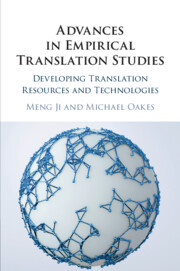Book contents
- Advances in Empirical Translation Studies
- Advances in Empirical Translation Studies
- Copyright page
- Contents
- Figures
- Tables
- Contributors
- Preface
- 1 Advances in Empirical Translation Studies
- 2 Development of Empirical Multilingual Analytical Instruments
- 3 Statistics for Corpus-Based and Corpus-Driven Approaches to Empirical Translation Studies
- 4 The Evolving Treatment of Semantics in Machine Translation
- 5 Translating and Disseminating World Health Organization Drinking-Water-Quality Guidelines in Japan
- 6 Developing Multilingual Automatic Semantic Annotation Systems
- 7 Leveraging Large Corpora for Translation Using Sketch Engine
- 8 Developing Computerised Health Translation Readability Evaluation Tools
- 9 Reordering Techniques in Japanese and English Machine Translation
- 10 Audiovisual Translation in Mercurial Mediascapes
- 11 Exploiting Data-Driven Hybrid Approaches to Translation in the EXPERT Project
- 12 Advances in Speech-to-Speech Translation Technologies
- 13 Challenges and Opportunities of Empirical Translation Studies
- Index
- References
6 - Developing Multilingual Automatic Semantic Annotation Systems
Published online by Cambridge University Press: 10 June 2019
- Advances in Empirical Translation Studies
- Advances in Empirical Translation Studies
- Copyright page
- Contents
- Figures
- Tables
- Contributors
- Preface
- 1 Advances in Empirical Translation Studies
- 2 Development of Empirical Multilingual Analytical Instruments
- 3 Statistics for Corpus-Based and Corpus-Driven Approaches to Empirical Translation Studies
- 4 The Evolving Treatment of Semantics in Machine Translation
- 5 Translating and Disseminating World Health Organization Drinking-Water-Quality Guidelines in Japan
- 6 Developing Multilingual Automatic Semantic Annotation Systems
- 7 Leveraging Large Corpora for Translation Using Sketch Engine
- 8 Developing Computerised Health Translation Readability Evaluation Tools
- 9 Reordering Techniques in Japanese and English Machine Translation
- 10 Audiovisual Translation in Mercurial Mediascapes
- 11 Exploiting Data-Driven Hybrid Approaches to Translation in the EXPERT Project
- 12 Advances in Speech-to-Speech Translation Technologies
- 13 Challenges and Opportunities of Empirical Translation Studies
- Index
- References
Summary
We report the development of a multilingual system for the semantic analysis of text. The research on the English Semantic Tagger started in 1990, and after that the system has been ported, first, to Finnish and Russian, and, thereafter, to Arabic, Chinese, Czech, Dutch, French, Italian, Malay, Portuguese, Spanish, Urdu, and Welsh. The development processes of the semantic taggers for English, Finnish, and Russian were relatively similar, involving manual construction of the semantic lexicons, whereas, to speed up the research, new bootstrapping methods including computational approaches have been utilised later in the creation of the semantic lexicons for the other languages. We describe these manual and automatic processes as well as envisaging directions for future development. The resulting multilingual framework of semantic taggers based on equivalent semantic lexicons and one common semantic taxonomy offers a wealth of potential applications which this chapter also illustrates. In addition to developing monolingual applications for these semantic taggers, it is also possible to create cross-lingual and multilingual applications. Furthermore, while the existing semantic analysis systems are designed for the analysis of general language, such systems can also be tailored for a specific purpose to deal more accurately with only one particular domain or task.
Keywords
Information
- Type
- Chapter
- Information
- Advances in Empirical Translation StudiesDeveloping Translation Resources and Technologies, pp. 94 - 109Publisher: Cambridge University PressPrint publication year: 2019
